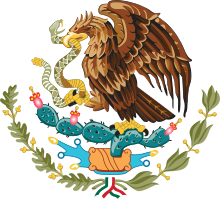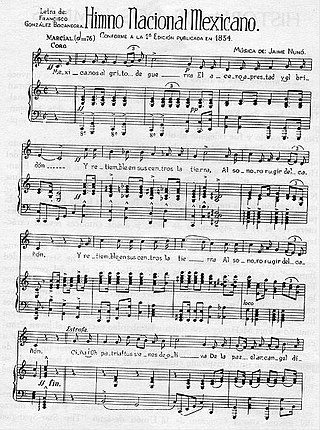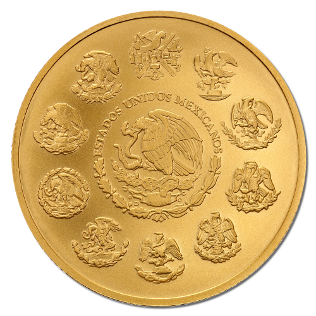
The national symbols of Mexico are the flag, the most coat of arms and the anthem. The flag is a vertical tricolor of green, white, and red. The coat of arms features a golden eagle eating a snake on top of a cactus.

The national symbols of Mexico are the flag, the most coat of arms and the anthem. The flag is a vertical tricolor of green, white, and red. The coat of arms features a golden eagle eating a snake on top of a cactus.

The current national flag was changed from a front-facing to a side-facing position. [1] The current flag is a vertical tricolor of green, white, and red with the national coat of arms charged in the center of the white stripe. While the meaning of the colors has changed over time, these three colors were adopted by Mexico following independence from Spain during the country's War of Independence.

The colors of the flag originated from the banner of the Army of the Three Guarantees, which lasted from 1821 until 1823. Originally, the colors had the following meanings: [3]
However, the meaning of the colors changed because of the secularization of the country, which was spearheaded by President Benito Juárez. [4] The new color meanings are as follows:
The World Encyclopedia of Flags, a book written by Alfred Znamierowski, also gives the following meaning to the colors of the flag: [3]
Since Article 3 of the Flag Law does not give an official symbolism to the colors, other meanings may be given to them. Other groups have used the national colors as part of their own logos or symbols. For example, the Institutional Revolutionary Party (PRI) political party has adopted the national colors as part of their logo. Another political party, the Party of the Democratic Revolution (PRD), also had the national colors as part of their logo, but changed them in the 1990s after a controversy surrounding impartiality issues, while the PRI did not. [5] Several states, such as Querétaro and Hidalgo have incorporated either elements of the national flag, or even the entire flag, into their coats of arms.

According to the official story of Mexico, the national coat of arms was inspired by an Aztec legend regarding the founding of Tenochtitlan. The Aztecs, then a nomadic tribe, were wandering throughout Mexico in search of a divine sign that would indicate the precise spot upon which they were to build their capital.

A closer look at the original Aztec codices, paintings, and the post-Cortesian codices shows that there was no snake in the original legends. While the Codex Fejérváry-Mayer depicts an eagle attacking a snake, other Aztec illustrations, like the Codex Mendoza, show only an eagle, while in the text of the Ramírez Codex, Huitzilopochtli asked the Aztecs to look for an eagle devouring a snake perched on a prickly pear cactus. In the text by Chimalpahin Cuauhtlehuanitzin, the eagle is devouring something, but it is not mentioned what it is. Still other versions show the eagle clutching the Aztec symbol of war, the Atl-Tlachinolli glyph, or "burning water".
The bird featured on the Mexican coat of arms is the golden eagle. This bird is known in Spanish as águila real (literally, "royal eagle"). In 1960, the Mexican ornithologist Martín del Campo identified the eagle in the pre-Hispanic codex as a crested caracara or "quebrantahuesos", a species common in Mexico (although the name "eagle" is taxonomically incorrect, as the caracara is a type of falcon). Even so, the prickly pear cactus is considered the Mexican plant for official purposes, and for the same reason is considered the official cactus of Mexico.


The National Anthem of Mexico (Spanish : Himno Nacional Mexicano) was officially adopted in 1943. The lyrics of the national anthem, which allude to Mexican victories in the heat of battle and cries of defending the homeland, were composed by poet Francisco González Bocanegra in 1853, after his fiancée locked him in a room. From 1854 until its official adoption, the lyrics underwent several modifications due to political changes in the country. Currently the full national anthem consists of the chorus, 1st stanza, 5th stanza, 6th stanza and 10th stanza.
At the same time the lyrics were composed, a set of music was chosen, the winner was Juan Bottesini, but his entry was disliked due to aesthetics. This rejection caused a second national contest to find music for the lyrics. [6] At the end of the second contest, Jaime Nunó, a Spanish-born band leader, arranged the music which now accompanies González's poem. The anthem, consisting of ten stanzas and a chorus, entered into use on September 16, 1854. During the second anthem competition, Nunó was the leader of several Mexican military bands. He had been invited to direct these bands by President Santa Anna, whom he had met in Cuba.
The modification of the lyrics was ordered by President Manuel Ávila Camacho in a decree printed in the Diario Oficial de la Federación. [7] The de jure or official language of Mexico is Spanish. Nevertheless, there are still people who only speak indigenous languages. On December 8, 2005, Article 39 of the national symbols law was adopted to allow for the translation of the lyrics into the native languages. The official translation is performed by the National Institute of Indigenous Languages (Instituto Nacional de Lenguas Indígenas). [8]



In the image the characters appear, that López Obrador has qualified as his references on various occasions. These are Benito Juárez (1806-1872) president who faced the French and American invasion; Francisco Ignacio Madero (1873-1913), forerunner of the Mexican Revolution, and Lázaro Cárdenas (1895-1970), president who nationalized oil. Also Miguel Hidalgo (1753-1811) new Hispanic priest who started the Grito de Dolores with which the War of Independence began, and José María Morelos (1765-1815), one of the main leaders of the independence struggle.

A new official logo featuring prominent women in the country's history on the occasion of the commemoration of International Women's Day. In the green and gold logo, used in official events and in government social networks five celebrities appear on the motto "Women transforming Mexico. March, women's month." In the center of the image appears holding a Mexican flag Leona Vicario (1789-1842), one of the most outstanding figures of the Mexican War of Independence (1810-1821) who served as an informant for the insurgents from Mexico City then capital of the vice-royalty. To her left, it is also drawn Josefa Ortiz de Domínguez (1768-1829), known as "la Corregidora" who played a fundamental role in the conspiracy that gave rise to the beginning of the independence movement from the state of Querétaro. The nun and neo-Hispanic writer sister sor Juana Inés de la Cruz (1648-1695), one of the main exponents of the Golden Age of literature in Spanish thanks to her lyrical and dramatic work, both religious and profane stars in the far left of the image. On the opposite side, the revolutionary Carmen Serdán (1875-1948), is drawn, who strongly supported from the city of Puebla to Francisco Ignacio Madero in his proclamation against the dictatorship of Porfirio Díaz, which was finally overthrown in 1911. On her side is located Elvia Carrillo Puerto (1878-1968), who was a feminist leader who fought for the right to vote of women in Mexico, which was achieved in 1953 and that she became one of the first women to hold office elected when elected as a deputy in the state congress of Yucatan.

The "Mexican National Anthem", also known by its incipit "Mexicans, at the cry of war", is the national anthem of Mexico. The anthem was first used in 1854. The lyrics of the national anthem, which allude to historical Mexican military victories in the heat of battle and including cries of defending the homeland, were composed by poet Francisco González Bocanegra after a Federal contest in 1853. Later, in 1854, he asked Jaime Nunó to compose the music that now accompanies González's poem. The national anthem, consisting of ten stanzas and a chorus, effectively entered into use on September 16, 1854.

The national flag of Poland consists of two horizontal stripes of equal width, the upper one white and the lower one red. The two colours are defined in the Polish constitution as the national colours. A variant of the flag with the national coat of arms in the middle of the white fess is legally reserved for official use abroad and at sea. A similar flag with the addition of a white eagle is used as the naval ensign of Poland.

The "Brazilian National Anthem" was composed by Francisco Manuel da Silva in 1831 and had been given at least two sets of unofficial lyrics before a 1922 decree by president Epitácio Pessoa gave the anthem its definitive, official lyrics, by Joaquim Osório Duque-Estrada, after several changes were made to his proposal, written in 1909.
The "National Anthem of Honduras" was adopted by presidential decree 42 in 1915. The lyrics were written by Augusto Constantino Coello and the music composed by Carlos Hartling.

The national flag of Armenia, also known as the tricolour, consists of three horizontal bands of equal width, red on the top, blue in the middle, and apricot on the bottom. The Armenian Supreme Soviet adopted the current flag on 24 August 1990. On 15 June 2006, the Law on the National Flag of Armenia, governing its usage, was passed by the National Assembly of Armenia.

The coat of arms of the Argentine Republic or Argentine shield was established in its current form in 1944 but has its origins in the seal of the General Constituent Assembly of 1813. It is supposed that it was chosen quickly because of the existence of a decree signed on February 22 sealed with the symbol. The first mention of it in a public document dates to March 12 of that same year, in which it is stated that the seal had to be used by the executive power, that is, the second triumvirate. On April 13 the National Assembly coined the new silver and gold coins, each with the seal of the assembly on the reverse, and on April 27 the coat of arms became a national emblem. Although the coat of arms is not currently shown on flags, the Buenos Aires-born military leader Manuel Belgrano ordered to paint it over the flag he gave to the city of San Salvador de Jujuy, and during the Argentine War of Independence most flags had the coat of arms.

The flag of Peru was adopted by the government of Peru in 1825, and modified in 1950. According to the article 49 of the Constitution of Peru, it is a vertical triband with red outer bands and a single white middle band. Depending on its use, it may be defaced with different emblems, and has different names. Flag day in Peru is celebrated on 7 June, the anniversary of the Battle of Arica.

The coat of arms of Poland is a white, crowned eagle with a golden beak and talons, on a red background.

The Great Seal of the State of New Mexico is the official seal of the U.S. state of New Mexico. It is enshrined in Article V, Section 10, of the New Mexico State Constitution, which requires a state emblem to be kept by the secretary of state for official documents and other expressions of statehood. Rooted in the official seal of the New Mexico Territory established in 1851, it was adopted in 1913, one year after New Mexico was admitted as the 47th state.
The Law on the National Coat of Arms, Flag and Anthem is a set of rules and guidelines passed by the Mexican government on the display and use of the flag (bandera), coat of arms (escudo) and the anthem (himno). The original law was passed in 1984 and it contains 7 chapters, a preamble and a section that contains the lyrics of the national anthem. The law itself was changed several times, most recently in 2005.

The National Palace is the seat of the federal executive in Mexico. Since 2018 it has also served as the official residence for the President of Mexico. It is located on Mexico City's main square, the Plaza de la Constitución. This site has been a palace for the ruling class of Mexico since the Aztec Empire, and much of the current palace's building materials are from the original one that belonged to the 16th-century leader Moctezuma II.

The flag of Martinique consists of a red triangle at the hoist, with two horizontal bands, the upper green and the lower black. It was adopted on 2 February 2023. The flag of France, its parent country, is also flown with official standing due to Martinique's status as a French overseas department/region. The assembly of Martinique flies a flag with the collectivity's logo on it to represent the government.

The coat of arms of Ecuador in its current form was established in 1900 based on an older version of 1845.
The national symbols of Lithuania are used in Lithuania and abroad to represent the country and its people, history, culture, and nature. These symbols are seen in official capacities, such as flags, coats of arms, postage stamps, and currency, and in URLs. They appear less formally as recurring themes in literature, art and folk art, heraldry, monuments, clothing, personal decoration, and as the names of parks, bridges, streets, and clubs. The less formal manifestations may be classified as national emblems.
The Symbols of the Department of Magdalena are the official symbols adopted by the Government of the Colombian Department of Magdalena to represent the identity of the Department of Magdalena as a subnational. These symbols intend to represent the Magdalenian identity by creating visual, verbal, and culturally iconic representations of Magdalena's history, culture, peoples, values and goals.

The coat of arms of Mexico is a national symbol of Mexico and depicts a Mexican (golden) eagle perched on a prickly pear cactus devouring a rattlesnake. The design is rooted in the legend that the Aztec people would know where to build their city once they saw an eagle eating a snake on top of a lake. The image has been an important symbol of Mexican politics and culture for centuries. To the people of Tenochtitlan, this symbol had strong religious connotations, and to the Europeans, it came to symbolize the triumph of good over evil.

The national flag of Mexico is a vertical tricolor of green, white, and red with the national coat of arms charged in the center of the white stripe. While the meaning of the colors has changed over time, these three colors were adopted by Mexico following independence from Spain during the country's War of Independence, and subsequent First Mexican Empire.

The Libertad coins are silver and gold bullion coins originating from Mexico and minted by the La Casa de Moneda de México. The Mexican Mint was established in 1535 and is the oldest mint in the Americas. The modern coins contain 99.9% silver or gold and are available in various sizes. Both metal coins have undergone a design change. In 1989, 3,500 1⁄4 ounce Libertad platinum coins were produced. Libertads are devoid of face value, yet are legal tender, still accepted as currency and guaranteed by Banco de México based on the market value of its gold or silver content.
National symbols of Turkey are symbols used to represent the citizens of the Republic of Turkey in Turkey and around the world.

The history of the flags of Mexico began before the Spanish conquest of the Aztec Empire, with the Flag Bearers of the Mexicas. The tri-coloured stripes date back to 1821. The green represents hope and victory, white stands for the purity of Mexican ideals and red represents the blood shed by the nation's martyrs. The modern day Flag of Mexico was adopted in 1968.